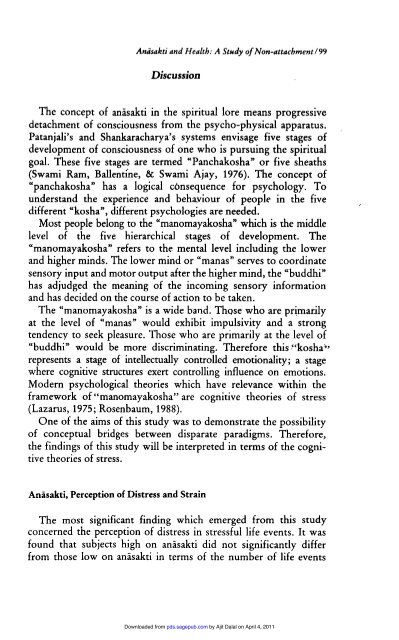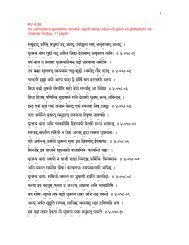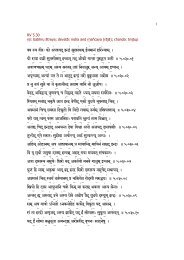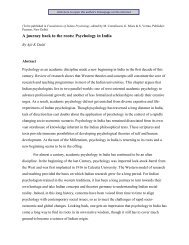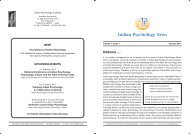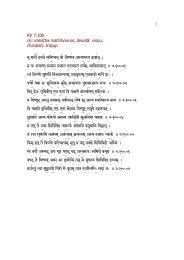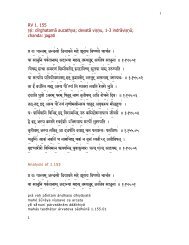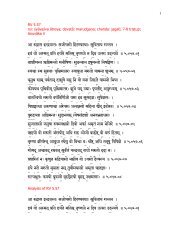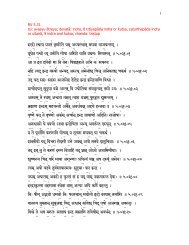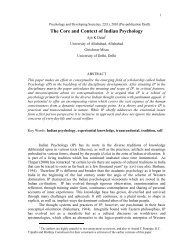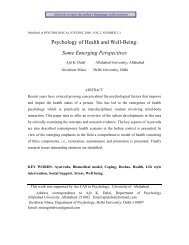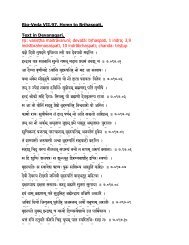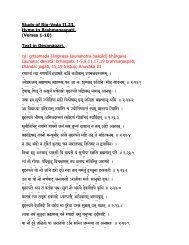Anasakti and health: A study of non-attachment - Indian Psychology ...
Anasakti and health: A study of non-attachment - Indian Psychology ...
Anasakti and health: A study of non-attachment - Indian Psychology ...
Create successful ePaper yourself
Turn your PDF publications into a flip-book with our unique Google optimized e-Paper software.
’99DiscussionThe concept <strong>of</strong> anasakti in the spiritual lore means progressivedetachment <strong>of</strong> consciousness from the psycho-physical apparatus.Patanjali’s <strong>and</strong> Shankaracharya’s systems envisage five stages <strong>of</strong>development <strong>of</strong> consciousness <strong>of</strong> one who is pursuing the spiritualgoal. These five stagesare termed &dquo;Panchakosha&dquo; or five sheathsSwami Ajay, 1976). The concept <strong>of</strong>(Swami Ram, Ballentine, &&dquo;panchakosha&dquo; has a logical consequence for psychology. Tounderst<strong>and</strong> the experience <strong>and</strong> behayiour <strong>of</strong> people in the fivedifferent &dquo;kosha&dquo;, different psychologiesare needed.Most people belong to the &dquo;manomayakosha&dquo; which is the middlelevel <strong>of</strong> the five hierarchical stages <strong>of</strong> development. The -&dquo;manomayakosha&dquo; refers to the mental level including the lower<strong>and</strong> higher minds. The lower mind or &dquo;manas&dquo; serves to coordinatesensory input <strong>and</strong> motor output after the higher mind, the &dquo;buddhi&dquo;has adjudged the meaning <strong>of</strong> the incoming sensory information<strong>and</strong> has decided on the course <strong>of</strong> action to be taken.The &dquo;manomayakosha&dquo; is a wide b<strong>and</strong>. ThQse who are primarilyat the level <strong>of</strong> &dquo;manas&dquo; would exhibit impulsivity <strong>and</strong> a strongtendency to seek pleasure. Those who are primarily at the level <strong>of</strong>&dquo;buddhi&dquo; would be more discriminating. Therefore this &dquo;kosha~~~represents a stage <strong>of</strong> intellectually controlled emotionality; a stagewhere cognitive structures exert controlling influence on emotions.Modern psychological theories which have relevance within theframework <strong>of</strong> &dquo;manomayakosha&dquo; are cognitive theories <strong>of</strong> stress(Lazarus, 1975; Rosenbaum, 1988).One <strong>of</strong> the aims <strong>of</strong> this <strong>study</strong> was to demonstrate the possibility<strong>of</strong> conceptual bridges between disparate paradigms. Therefore,the findings <strong>of</strong> this <strong>study</strong> will be interpreted in terms <strong>of</strong> the cognitivetheories <strong>of</strong> stress.Anisakti, Perception<strong>of</strong> Distress <strong>and</strong> StrainThe most significant finding which emerged from this <strong>study</strong>concerned the perception <strong>of</strong> distress in stressful life events. It wasfound that subjects high on anasakti did not significantly differfrom those low on anasakti in terms <strong>of</strong> the number <strong>of</strong> life eventsDownloaded from pds.sagepub.com by Ajit Dalal on April 4, 2011


